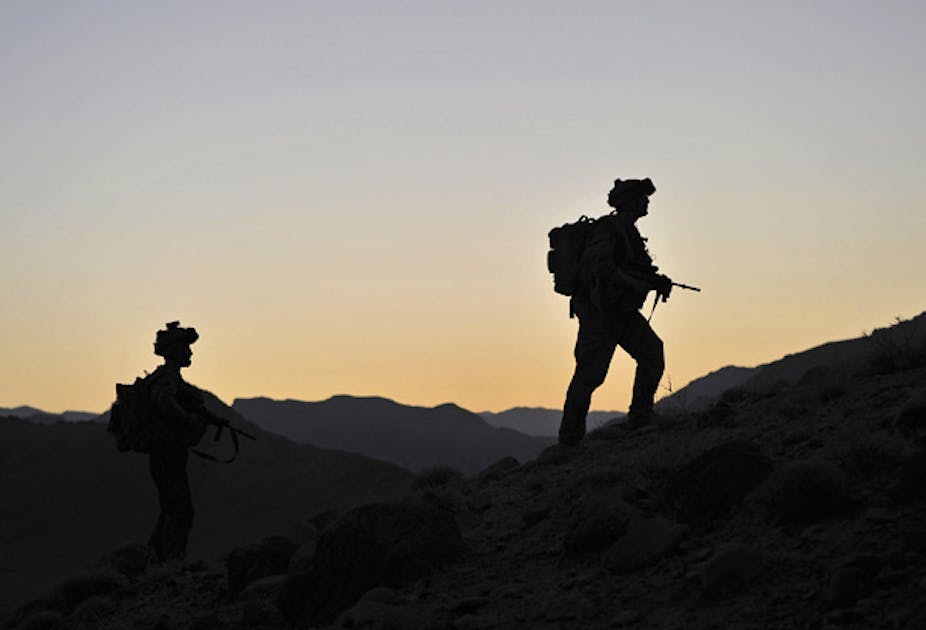While many people are relieved Australia is concluding its operations in Afghanistan, the effects of our involvement have, in many ways, only just begun. Retired Major General John Cantwell, the author of the military trauma book Exit Wounds, and veterans groups argue Australia will see a tidal wave of psychological trauma among veterans in the coming years.
Australians have been consistently involved in combat, peacekeeping and humanitarian roles for about 20 years. Since 1999, 45,000 Australians have served on overseas operations with the Australian Defence Force (ADF) on around 134,000 individual deployments.
In the Middle East, we have lost 40 men and we’ve seen around 240 serious injuries across both genders. Deaths and injuries have mostly been combat-related, through improvised explosive devices, firefights (a large exchange of bullets), green on blue attacks (from rogue members of the Afghan security forces) as well as other accidents.
Psychological trauma, however is more prolific and much harder to identify.
The Middle East Area of Operations Health Study, released last week, surveyed 3,000 Australian Defence Force (ADF) members deployed in Afghanistan and Iraq from June 2010 to June 2012. The study reports that deployment to the Middle East has doubled the incidence of psychological distress and trauma, and post-traumatic stress disorders (PTSD), manifesting in alcoholism, drug abuse and suicide.
The report builds on a parliamentary inquiry report, released earlier this year, and highlights both the ongoing development of services and support for traumatised military personnel. It also leads us to ask: are we doing enough, and are we doing it well?
Prevalence
Historically, trauma has gone by numerous names, from shell shock, to battle exhaustion to war neurosis. In 1980, PTSD was formalised in the Diagnostic and Statistical Manual of Mental Disorders (DSM).
While there’s widespread agreement about the causes of PTSD, there is much disagreement about its prevalence. The latest report states 6% of personnel who have left the ADF and 2.7% of serving members report symptoms of PTSD. While the authors acknowledge they haven’t given the matter the in-depth analysis it requires, other data sources differ considerably.

According to the 2010 ADF Mental Health Prevalence and Wellbeing Study, nearly 2,491 of 51,000 staff deployed between 2002 and 2009 suffered from PTSD, amounting to about 8% of serving members. But this only covers personnel diagnosed with PTSD. Another one in five had suffered a mental disorder in the previous 12 months, and more than half struggled with anxiety, alcohol or affective disorders at some stage in their life.
If you listen to veterans’ groups – the groups of men and women who have often been in this situation themselves, and whom veterans feel safest confiding in – the rate of PTSD and combat stress is reportedly closer to 30% among those who have left.
Detection
Military personnel returning from service are supposed to undergo post-operational psychological screening (POPS), which includes a questionnaire and interview. The contact with a psychologist should occur within three to six months after returning form deployment.
But there are some problems with this process. The high rate of deployment – itself a contributing factor to PTSD because of the chance of repeated exposure to trauma – has created significant backlogs in providing this service to returning personnel. As well, the stigma of mental illness remains a consistent challenge for the identification and treatment of trauma, despite the ADF and associated agencies recognising this.
Treatment
For those who are diagnosed, there are a host of psychological and pharmacological treatments available. But they’re only part of the recovery story.
An equally important, but often overlooked component, is the role of veterans groups in providing a sanctuary for those experiencing trauma through a sense of camaraderie among veterans. Rebuilding, through a sense of shared experience, lessens the stigma of psychological trauma. These groups also help to remove the stigma of trauma being merely a psychological pathology.

The ADF and its preferred providers have created a comprehensive approach to promoting good mental health. This includes recognising health issues, building peer support and engaging families, command and service providers. A key plank has been developing the coherency of services on departure to civilian life.
The ADF Mental Health and Wellbeing Plan (2012-2015), which was released in February, also shows the ADF is attempting to improve communications strategies, develop e-services, up-skill service providers, improve pathways to care and will continue to build peers support networks.
A common complaint among veterans, however, is the lack of service experience among counsellors. This has been a major challenge, as personnel struggle with trauma and their new life away from the structured and team-based context of service life. The sense that no-one, other than other military personnel with similar experiences, can understand generates a profound sense of loneliness.
What can we do better?
It is only in recent years that the ADF has demonstrated a strong understanding of the complexity of PTSD. Bureaucratic supports are in the process of catching up. Recent reports have begun to name the key issues and find appropriate strategies to support returning veterans, both in, and after service.
But broader, culturally sophisticated approaches would improve the outcomes of veterans with PTSD. Take gender, for instance. Men, particularly those in the military, are reluctant to acknowledge weakness, and military training further instills the imperative to remain in control. Women veterans, often struggle to identify as “veterans”, given its masculine connotations. This undermines their capacity to acknowledge their condition and seek help.
Research literature suggests that the current paradigm tends to reassert negative perceptions of trauma, further entrenching the veteran’s sense of stigma.
Whether we see a tidal wave or a trickle of PTSD, we must continue to work on new therapeutic approaches that develop a sense of trauma wisdom among the afflicted, and their support networks, as well as diminishing the stigma of diagnosis.

